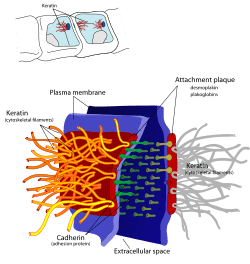Desmosome
| Desmosome | |
|---|---|
 desmosomes | |
 Cell adhesion in desmosomes | |
| Details | |
| Identifiers | |
| Latin |
Desmosoma Macula |
| TH | H1.00.01.1.02015 |
| FMA | 67412 |
A desmosome (/ˈdɛzməˌsoʊm/;[1][2] "binding body"), also known as a macula adhaerens (plural: maculae adhaerentes) (Latin for adhering spot), is a cell structure specialized for cell-to-cell adhesion. A type of junctional complex, they are localized spot-like adhesions randomly arranged on the lateral sides of plasma membranes.
Desmosomes help to resist shearing forces and are found in simple and stratified squamous epithelium. The intercellular space is very wide (about 30 nm). Desmosomes are also found in muscle tissue where they bind muscle cells to one another.
Structure
Desmosomes are molecular complexes of cell adhesion proteins and linking proteins that attach the cell surface adhesion proteins to intracellular keratin cytoskeletal filaments.
The cell adhesion proteins of the desmosome, desmoglein and desmocollin, are members of the cadherin family of cell adhesion molecules. They are transmembrane proteins that bridge the space between adjacent epithelial cells by way of homophilic binding of their extracellular domains to other desmosomal cadherins on the adjacent cell. Both have five extracellular domains, and have calcium-binding vulvae.
The extracellular domain of the desmosome is called the extracellular core domain (ECD) or the desmoglea, and is bisected by an electron-dense midline where the desmoglein and desmocollin proteins bind to each other. These proteins can bind in a W, S, or λ manner.
On the cytoplasmic side of the plasma membrane, there are two dense structures called the outer dense plaque (ODP) and the inner dense plaque (IDP). These are spanned by the desmoplakin protein.[3] The outer dense plaque is where the cytoplasmic domains of the cadherins attach to desmoplakin via plakoglobin and plakophilin. The Inner Dense Plaque is where desmoplakin attaches to the intermediate filaments of the cell.
Arrhythmogenic right ventricular cardiomyopathy
Mutations within the desmosome are the main cause of Arrhythmogenic right ventricular cardiomyopathy (ARVC). It is a life-threatening disease with the molecular underpinnings being the desmosomal constituents (in rank of highest mutation rates) Plakophilin 2, Desmoplakin, Desmoglein-2, Desmocollin 2 and Plakoglobin. It often afflicts (although not exclusive to) young male athletes. The current incidence within the population is accepted as 1/10,000 however it is thought that 1/200 may have a mutation that may predispose to ARVC.[4]
Blistering diseases
If the connecting adjacent epithelial cells of the skin are not functioning correctly, layers of the skin can pull apart and allow abnormal movements of fluid within the skin, resulting in blisters and other tissue damage. Blistering diseases such as Pemphigus vulgaris and Pemphigus foliaceus are autoimmune diseases in which auto-antibodies target the proteins desmoglein 3 and desmoglein 1 respectively. The symptoms of the diseases are caused by the subsequent disruption to the desmosome-keratin filament complex leading to a breakdown in cell adhesion. Similar outbreaks occur with Hailey–Hailey disease, though the cause is not autoimmune, but, rather genetic. A haploinsufficiency of the ATP2C1 gene located on chromosome 3, which encodes the protein hSPCA1, causes malformation of the desmosomes.
Etymology
The first combining form, desmo-, New Latin from Greek desmos, band, carries meaning of binding or bonding things together. Combined with -some, which comes from soma, body, it thus makes a desmosome a "binding body", a name that aptly describes how desmosomes bind cells together.
See also
References
- ↑ "Desmosome". Oxford Dictionaries. Oxford University Press. Retrieved 2016-01-21.
- ↑ "Desmosome". Merriam-Webster Dictionary. Retrieved 2016-01-21.
- ↑ Bornslaeger, E. A.; Corcoran, C. M.; Stappenbeck, T. S.; Green, K. J. (Aug 1996). "Breaking the connection: displacement of the desmosomal plaque protein desmoplakin from cell-cell interfaces disrupts anchorage of intermediate filament bundles and alters intercellular junction assembly". Journal of Cell Biology (Free full text). 134 (4): 985–1001. doi:10.1083/jcb.134.4.985. ISSN 0021-9525. PMC 2120955
 . PMID 8769422.
. PMID 8769422. - ↑ Lahtinen, AM; Lehtonen, E; Marjamaa, A; Kaartinen, M; Heliö, T; Porthan, K; Oikarinen, L; Toivonen, L; Swan, H; Jula, A; Peltonen, L; Palotie, A; Salomaa, V; Kontula, K (2011). "Population-prevalent desmosomal mutations predisposing to arrhythmogenic right ventricular cardiomyopathy.". Heart Rhythm. 8 (8): 1214–21. doi:10.1016/j.hrthm.2011.03.015. PMID 21397041.
- Green Kj, J. J.; Jones, J. C. (1 June 1996). "Desmosomes and hemidesmosomes: structure and function of molecular components" (Free full text). The FASEB Journal. 10 (8): 871–881. ISSN 0892-6638. PMID 8666164.
- Desmosomes Connect Intermediate Filaments from Cell to Cell in Molecular Biology of the Cell by Bruce Alberts, Alexander Johnson, Julian Lewis, Martin Raff, Keith Roberts and Peter Walter (2002) Published by Garland Science. ISBN 0-8153-4072-9
External links
| Wikimedia Commons has media related to desmosomes. |
- MedEd at Loyola Histo/practical/epithelium/hp1-13.html
- Histology image: 20502loa – Histology Learning System at Boston University - "Ultrastructure of the Cell: microvillous border, Junctional Complex of absorptive epithelium"
- Histology image: 20604loa – Histology Learning System at Boston University - "Ultrastructure of the Cell: microvillous border and Junctional Complex, desmosomes and zonula adhaerens"
- Histology image: 22502loa – Histology Learning System at Boston University - "Ultrastructure of the Cell: cardiac muscle, intercalated disk"